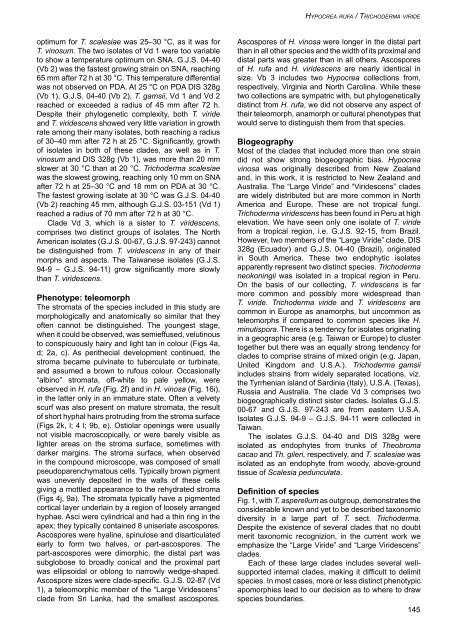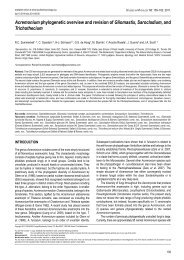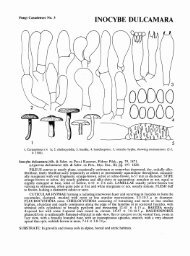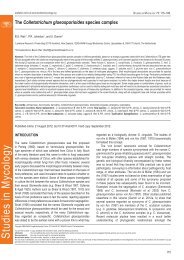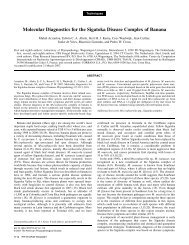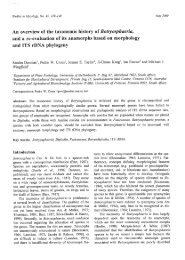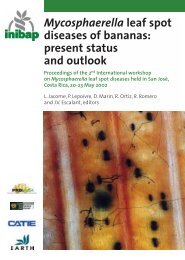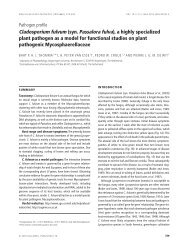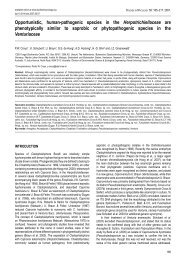Hypocrea rufa/Trichoderma viride: a reassessment, and ... - CBS
Hypocrea rufa/Trichoderma viride: a reassessment, and ... - CBS
Hypocrea rufa/Trichoderma viride: a reassessment, and ... - CBS
You also want an ePaper? Increase the reach of your titles
YUMPU automatically turns print PDFs into web optimized ePapers that Google loves.
optimum for T. scalesiae was 25–30 °C, as it was for<br />
T. vinosum. The two isolates of Vd 1 were too variable<br />
to show a temperature optimum on SNA. G.J.S. 04-40<br />
(Vb 2) was the fastest growing strain on SNA, reaching<br />
65 mm after 72 h at 30 °C. This temperature differential<br />
was not observed on PDA. At 25 °C on PDA DIS 328g<br />
(Vb 1), G.J.S. 04-40 (Vb 2), T. gamsii, Vd 1 <strong>and</strong> Vd 2<br />
reached or exceeded a radius of 45 mm after 72 h.<br />
Despite their phylogenetic complexity, both T. <strong>viride</strong><br />
<strong>and</strong> T. <strong>viride</strong>scens showed very little variation in growth<br />
rate among their many isolates, both reaching a radius<br />
of 30–40 mm after 72 h at 25 °C. Significantly, growth<br />
of isolates in both of these clades, as well as in T.<br />
vinosum <strong>and</strong> DIS 328g (Vb 1), was more than 20 mm<br />
slower at 30 °C than at 20 °C. <strong>Trichoderma</strong> scalesiae<br />
was the slowest growing, reaching only 10 mm on SNA<br />
after 72 h at 25–30 °C <strong>and</strong> 18 mm on PDA at 30 °C.<br />
The fastest growing isolate at 30 °C was G.J.S. 04-40<br />
(Vb 2) reaching 45 mm, although G.J.S. 03-151 (Vd 1)<br />
reached a radius of 70 mm after 72 h at 30 °C.<br />
Clade Vd 3, which is a sister to T. <strong>viride</strong>scens,<br />
comprises two distinct groups of isolates. The North<br />
American isolates (G.J.S. 00-67, G.J.S. 97-243) cannot<br />
be distinguished from T. <strong>viride</strong>scens in any of their<br />
morphs <strong>and</strong> aspects. The Taiwanese isolates (G.J.S.<br />
94-9 – G.J.S. 94-11) grow significantly more slowly<br />
than T. <strong>viride</strong>scens.<br />
Phenotype: teleomorph<br />
The stromata of the species included in this study are<br />
morphologically <strong>and</strong> anatomically so similar that they<br />
often cannot be distinguished. The youngest stage,<br />
when it could be observed, was semieffused, velutinous<br />
to conspicuously hairy <strong>and</strong> light tan in colour (Figs 4a,<br />
d; 2a, c). As perithecial development continued, the<br />
stroma became pulvinate to tuberculate or turbinate,<br />
<strong>and</strong> assumed a brown to rufous colour. Occasionally<br />
“albino” stromata, off-white to pale yellow, were<br />
observed in H. <strong>rufa</strong> (Fig. 2f) <strong>and</strong> in H. vinosa (Fig. 16i),<br />
in the latter only in an immature state. Often a velvety<br />
scurf was also present on mature stromata, the result<br />
of short hyphal hairs protruding from the stroma surface<br />
(Figs 2k, l; 4 l; 9b, e). Ostiolar openings were usually<br />
not visible macroscopically, or were barely visible as<br />
lighter areas on the stroma surface, sometimes with<br />
darker margins. The stroma surface, when observed<br />
in the compound microscope, was composed of small<br />
pseudoparenchymatous cells. Typically brown pigment<br />
was unevenly deposited in the walls of these cells<br />
giving a mottled appearance to the rehydrated stroma<br />
(Figs 4j, 9a). The stromata typically have a pigmented<br />
cortical layer underlain by a region of loosely arranged<br />
hyphae. Asci were cylindrical <strong>and</strong> had a thin ring in the<br />
apex; they typically contained 8 uniseriate ascospores.<br />
Ascospores were hyaline, spinulose <strong>and</strong> disarticulated<br />
early to form two halves, or part-ascospores. The<br />
part-ascospores were dimorphic, the distal part was<br />
subglobose to broadly conical <strong>and</strong> the proximal part<br />
was ellipsoidal or oblong to narrowly wedge-shaped.<br />
Ascospore sizes were clade-specific. G.J.S. 02-87 (Vd<br />
1), a teleomorphic member of the “Large Viridescens”<br />
clade from Sri Lanka, had the smallest ascospores.<br />
HYPOCREA RUFA / TRICHODERMA VIRIDE<br />
Ascospores of H. vinosa were longer in the distal part<br />
than in all other species <strong>and</strong> the width of its proximal <strong>and</strong><br />
distal parts was greater than in all others. Ascospores<br />
of H. <strong>rufa</strong> <strong>and</strong> H. <strong>viride</strong>scens are nearly identical in<br />
size. Vb 3 includes two <strong>Hypocrea</strong> collections from,<br />
respectively, Virginia <strong>and</strong> North Carolina. While these<br />
two collections are sympatric with, but phylogenetically<br />
distinct from H. <strong>rufa</strong>, we did not observe any aspect of<br />
their teleomorph, anamorph or cultural phenotypes that<br />
would serve to distinguish them from that species.<br />
Biogeography<br />
Most of the clades that included more than one strain<br />
did not show strong biogeographic bias. <strong>Hypocrea</strong><br />
vinosa was originally described from New Zeal<strong>and</strong><br />
<strong>and</strong>, in this work, it is restricted to New Zeal<strong>and</strong> <strong>and</strong><br />
Australia. The “Large Viride” <strong>and</strong> “Viridescens” clades<br />
are widely distributed but are more common in North<br />
America <strong>and</strong> Europe. These are not tropical fungi.<br />
<strong>Trichoderma</strong> <strong>viride</strong>scens has been found in Peru at high<br />
elevation. We have seen only one isolate of T. <strong>viride</strong><br />
from a tropical region, i.e. G.J.S. 92-15, from Brazil.<br />
However, two members of the “Large Viride” clade, DIS<br />
328g (Ecuador) <strong>and</strong> G.J.S. 04-40 (Brazil), originated<br />
in South America. These two endophytic isolates<br />
apparently represent two distinct species. <strong>Trichoderma</strong><br />
neokoningii was isolated in a tropical region in Peru.<br />
On the basis of our collecting, T. <strong>viride</strong>scens is far<br />
more common <strong>and</strong> possibly more widespread than<br />
T. <strong>viride</strong>. <strong>Trichoderma</strong> <strong>viride</strong> <strong>and</strong> T. <strong>viride</strong>scens are<br />
common in Europe as anamorphs, but uncommon as<br />
teleomorphs if compared to common species like H.<br />
minutispora. There is a tendency for isolates originating<br />
in a geographic area (e.g. Taiwan or Europe) to cluster<br />
together but there was an equally strong tendency for<br />
clades to comprise strains of mixed origin (e.g. Japan,<br />
United Kingdom <strong>and</strong> U.S.A.). <strong>Trichoderma</strong> gamsii<br />
includes strains from widely separated locations, viz.<br />
the Tyrrhenian isl<strong>and</strong> of Sardinia (Italy), U.S.A. (Texas),<br />
Russia <strong>and</strong> Australia. The clade Vd 3 comprises two<br />
biogeographically distinct sister clades. Isolates G.J.S.<br />
00-67 <strong>and</strong> G.J.S. 97-243 are from eastern U.S.A.<br />
Isolates G.J.S. 94-9 – G.J.S. 94-11 were collected in<br />
Taiwan.<br />
The isolates G.J.S. 04-40 <strong>and</strong> DIS 328g were<br />
isolated as endophytes from trunks of Theobroma<br />
cacao <strong>and</strong> Th. gileri, respectively, <strong>and</strong> T. scalesiae was<br />
isolated as an endophyte from woody, above-ground<br />
tissue of Scalesia pedunculata.<br />
Definition of species<br />
Fig. 1, with T. asperellum as outgroup, demonstrates the<br />
considerable known <strong>and</strong> yet to be described taxonomic<br />
diversity in a large part of T. sect. <strong>Trichoderma</strong>.<br />
Despite the existence of several clades that no doubt<br />
merit taxonomic recognizion, in the current work we<br />
emphasize the “Large Viride” <strong>and</strong> “Large Viridescens”<br />
clades.<br />
Each of these large clades includes several wellsupported<br />
internal clades, making it difficult to delimit<br />
species. In most cases, more or less distinct phenotypic<br />
apomorphies lead to our decision as to where to draw<br />
species boundaries.<br />
145


